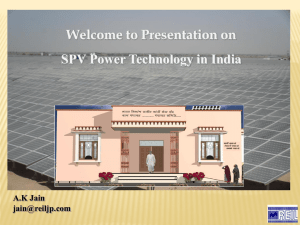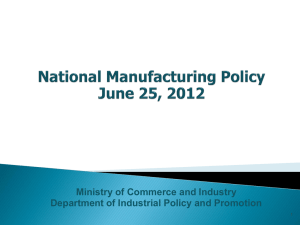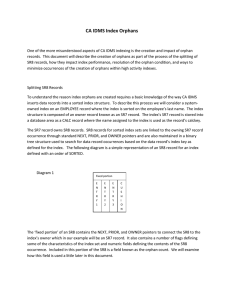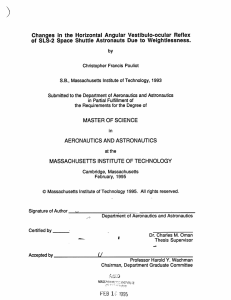Presentation on Clean Development Mechanism
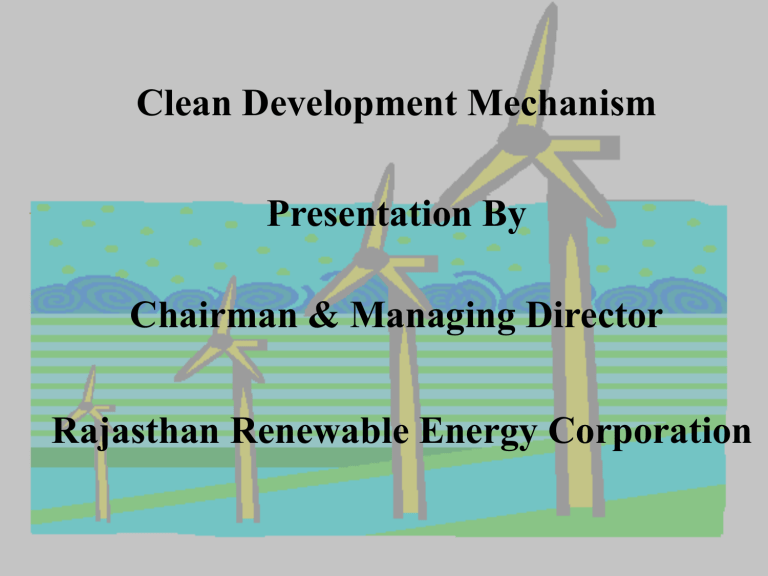
Clean Development Mechanism
Presentation By
Chairman & Managing Director
Rajasthan Renewable Energy Corporation
Introduction
Clean Development Mechanism(CDM) is a unique instrument based on understanding and cooperation among the nations for adopting a new outlook for economic activities aiming at protecting the world eco-system.
Green House Gases
Accumulation of Carbon Di Oxide (CO
2
),
Chloro Floro Carbons (CFC), Methane
(CH
4
) & Nitrous Oxide (NO x
) in the atmosphere cover the Green House Gases
(GHG)
GHGs are accumulated in the atmosphere due to combustion of fossil fuels like coal, oil and natural gases etc.
Kyoto Protocol
Industrialization since 18 th century, generation of
Green House Gases has resulted in progressive global warming.
Kyoto Protocol drafted at Kyoto, in 1992 to combat global climate change .
Joint implementation (Developed Countries)
Clean Development Mechanism (Developing
Countries)
International Emission Trading
Credit through special market)
(Emission
Sustainable Development
This calls for balanced outlook between the pace of economic development & environmental conservation & discourages activities that could hurt the Environment.
Development that meets the needs of the present without compromising the ability of future generations to meet their own needs.
The primary objective of sustainable development is to reduce the absolute poverty of the world’s poor through providing lasting & secure livelihoods that minimise resources depletion, environmental degradation, natural disruption & social instability.
CDM Objectives
To assist developing countries in achieving sustainable development & in contributing to ultimate objectives of United Nations Framework
Convention on Climate Change (UNFCCC )
To assist developing countries in achieving compliance with their qualified emission limit & reduction commitments.
Eligibility Criterion
Social well being
Economic well being
Environmental well being
Technological well being
Indian Scenario
Formation of an Advisory Group on Climate
Change under Ministry of Environment and Forest
(MoEF) which is the nodal agency on climate change issue in India.
Energy Sector is main CO
2 for 87% of CO
2 emissions.
emitter accounting
Biomass burning and agriculture sector main source of NO x emission.
GHG emission in India is 3% of the world.
Continue…
Because of high potential of GHG reduction, India can avail new opportunity through CDM projects.
India can capture 10% of Global CDM mark.
Annual revenue estimated range from US$ 10 million to 330 million
Benefits from Estimated Emission Reduction from the Renewable Energy Projects
Type of Project Tones of CO
2
/
MW/Year
Monetized ER benefits/MW/Year
5MW project for the crediting period of 7 years
Biomass
(90% PLF)
(50% PLF)
Small Hydel
(35% PLF)
Solar
(Thermal)
Wind Farm
(20% PLF)
7,000
3,850
3,000
10 per solar thermal pump (3 HP) per year
1,750
Rs. 14 lacs
Rs. 7.70 lacs
Rs. 6 lacs
Rs. 10 Crores
Rs. 5.5 Crores
Rs. 2 Crores)
Rs. 2,000 per solar thermal pump (3HP) per year
Project specific
Rs. 3.5 lacs Rs. 1 Crore
CDM Options
Projects prioritised for CDM
Coal power plant using IGCC (Integrated
Gasification Combined Cycle)
Coal Power Plant using PFBC (Pressurised Fluidised
Bed Combustion)
Renovation and Modernization of Power Plants
Wind based power generation
Solar Thermal Energy for Power generation
Underground Coal gasification technology projects
Continue…
Wind Pumps for agriculture
Direct reduction process in the iron & steel industry
Continuous pulp digesters in the pulp & paper industry
Demand side management by efficient motors
Barriers
Clear methodologies yet to be defined.
Procedures and process still to be finalised.
Others barriers perceived by many countries are
Lack of awareness
Financial barriers due to present low and uncertain returns
Technology barriers
Institutional barriers
Infrastructure limitations
High transaction cost
Small-Scale Projects
The following categories of projects qualify for fast-track approval procedure
Renewable Energy projects with minimum output capacity equivalent up to 15 MW
Energy efficiency improvements which reduce energy consumption on supply or demand side by up to 15 Gwh/yr
Other project activities that both reduce emission and directly emit less than 15kt of CO
2 annually.
Horizon for Renewables
Multi technology development programmes initiated by GOI define best options for GHG emission reductions.
MNES suggested for a study and development of overall methodology for Renewable Energy
Project under CDM.
Wind, Solar, Hydel & Biomass Projects suggested to be brought under positive list of CDM.
Development in Rajasthan
(RREC Activities)
RREC has taken up work of propagation of SPV based technology in the state by organising installation of
SPV system as under :
Decentralized Systems:
SPV Home Lighting System
SPV Street Lighting System
SPV Pumping System
Centralized Systems:
Remote village electrification through SPV stand alone Power Plants
Grid Interactive SPV Power Plants
SPV Decentralised Systems:
1
S.
No.
System Achieveme nts (Nos.)
HLS 60864
Total PV capacity
(MW)
Energy
Produced so far
2.25
(Units)
66.48 lacs
2 SLS
3 Pumps
2135
116
0.15
0.11
5.37 lacs
10.28 lacs
Total 2.51
82.13 lacs
3
1
2
S.
No.
Grid Interactive Solar Power Units
SPV Centralized Systems
System Total PV capacity
(KW)
Year of
Installation
Energy
Produced so far
(Units)
25 2001 0.89 lacs Govt.
Secretariats
Vidhan Sabha 25 2001 0.88 lacs
Gorir, Jhunjhunu 100 2004 0.06 lacs
Total 150 1.83 lacs
SPV Centralized Systems
Remote Village Electrification
Work of 48 villages has been completed and of 40 other villages in progress.
Wind Energy Based Systems
Wind Projects : 253 MW Capacity (3808 lac units)
Sanctioned Projects
Installed Projects
Projects in Pipeline
320 MW
253 MW
67 MW
Investment in the state Rs. 1200 Crore
Electricity produced 2003-04 141 M. Units
Electricity produced 2004-05
Reduction in carbon emission
240 M. Units
332500 Tons
Biomass Energy Based Systems
Biomass Based Power Projects in Rajasthan
Rajasthan State has immense potential in form of
Juli-flora (Vilayati Babool), Mustard husk, Ricehusk and other agriculture residues for the biomass fuel.
Based on the biomass fuel, power project of IPPs, totalling to 113 MW have been registered with
RREC.
Out of this, 7.8 MW (7 MW net) proejct of M/s.
Kalptaru Power Transmission Ltd. have been comissioned at Padampur, Sri Ganganagar
District on 15 th July, 2003.
Future plans for SPV Systems
RREC plan to propagate SPV based systems in the state to achieve targets of systems during coming years as under :-
Year SPV Home lighting systems
2004-05 15000
SPV Street
Lighting
System
100
SPV pumping systems
50
2005-06
2006-07
20000
25000
100
100
100
200
Future Projection for Biomass Energy
7.5 MW power project of M/s. Chambal Power Ltd., is expected to be commissioned at village Rangpur, Kota in March, 2005.
Other power projects are in Pipeline and are expected to be commissioned in March, 2006.
Continue..
Village Energy Security Through Biomass
MNES, GOI, has launched a National Programme on
Village Energy Security through Biomass.
The Programme aims at meeting energy requirements of a village through locally available biomass resources with full participation of the local community.
The programme will provide quantum jump to rural economy and contribute to growth with equity and employment generation.
Under the programme, RREC has identified 19 locations to implement the test projects.
The location selected are un-electrified remote villages / hamlets of the electrified villages which would not be electrified by conventional means upto 2012.
Future projection towards ULG projects
Rajasthan has large reserves of lignite
Till now 3173 million MT Geological reserve of
Lignite have been assessed in Barmer, Bikaner, Nagaur
& Jaisalmer District.
The deposits so far assessed in Rajasthan have potential to generate 2500 MW power from shall on deposits (through CBM technique) and more than 15000
MW from deep seated lignite (through ULG process) sustainable for more than 100 years.
Continue …..
RREC has selected a site in village Bharka-Bothiya in Barmer District and applied for prospecting licence to Mines & Mineral Deptt., GoR for exploration of
Petroleum Product and setting up of Power Project based on syn Gas
The cost of power generation would be very less in compare to other forthcoming power projects based on
Coal, Natural Gas etc.
Green House Gases would be reduced to a great extent and as such, this would be a qualified candidate for CDM project
.
ISCC Mathania
o
Capacity
CC Block o
Solar Block
Out put o
CC Block o
Solar Block
CO
2
Abatement o
Solar Portion o
Total abatement of
CO
2 in plant life -
Cost of the project -
Cost of power produced-
-
-
-
-
-
155 MW
125 MW
30 MW
853 GWh
63 GWh
65100 Tons/a
13.96 Million Tons
Rs. 822 Crore
Rs. 2.64 per/kwh (LEC)

